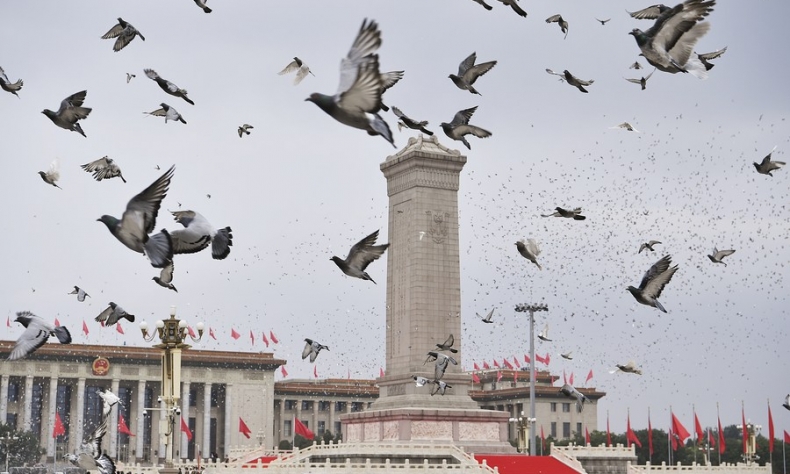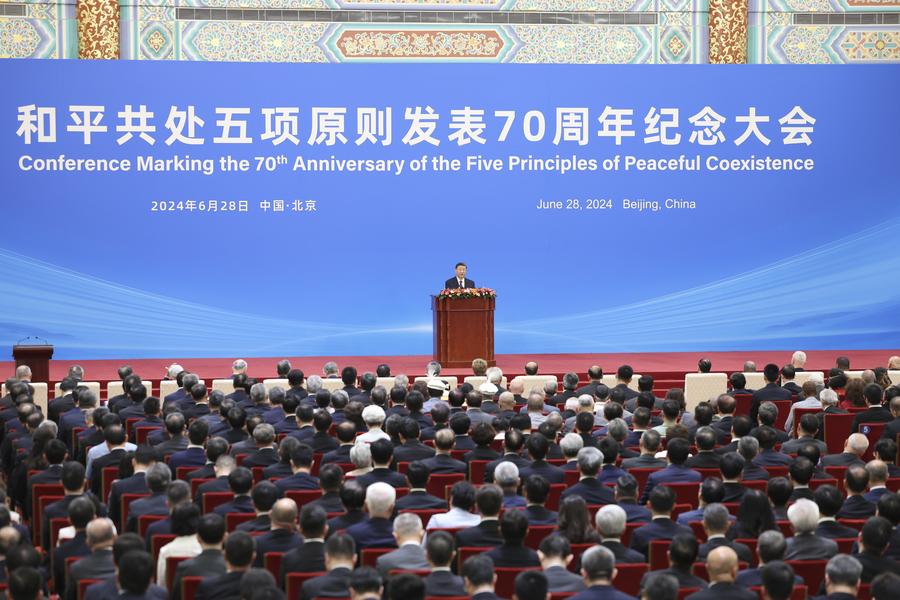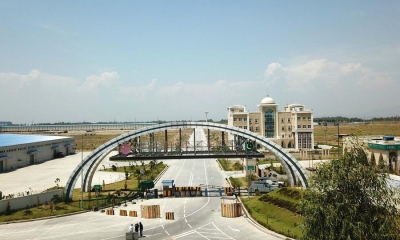The Five Principles of Peaceful Coexistence: Blazing Hope and Clarion Call

The vision of building a community with a shared future for mankind is the most effective move to sustain, promote and upgrade the Five Principles of Peaceful Coexistence in the new circumstances.
As every cloud has a silver lining, the Five Principles of Peaceful Coexistence proposed by China 70 years ago is an unflickering hope for the world to recover from menace of global disorder, war hysteria, zero-sum game, deglobalization, bloc politics, new cold war and economic colonization.
Owing to its universal appeal, the Five Principles of Peaceful Coexistence incorporated into the Chinese constitution is a one-size-fits-all approach that offers global insight into how developed countries and developing countries can live together with cohesion. They guide how global north and global south can forge ahead side by side. They impart the knowledge of how lasting peace and robust growth on international chessboard lie in shared community and global governance system.
The aura of five principles is again in the spotlight after Chinese President Xi Jinping has inspired the world’s consciousness by his wake-up speech celebrating 70 years of anniversary of the Five Principles of Coexistence and vision of building a community with a shared future for mankind.
President Xi created positive ripples when saying The Five Principles of Peaceful Coexistence “has withstood the test of international vicissitudes, and has become more appealing rather than obsolete. Seventy years later today, challenged by the historic question of ‘what kind of world to build and how to build it,’ China has answered the call of the times by proposing a community with a shared future for mankind. Today, this Chinese initiative has become an international consensus. The beautiful vision has been put into productive actions. It is moving the world to a bright future of peace, security, prosperity and progress.”
As for dynamics of the Five Principles of Peaceful Coexistence and Chinese wisdom of building a community with a shared future for mankind, President Xi in his speech revealed “both are rooted in traditional Chinese values such as “Be kind to your neighbor”, “Seek amity through integrity” and “Promote harmony among all nations”. Both attest to China’s diplomatic tenets of self-confidence, self-reliance, justice, protection of the disadvantaged, and benevolence. Both demonstrate the broad vision of the Communist Party of China to contribute more to humanity. Both manifest China’s firm resolve to follow the path of peaceful development. The vision of building a community with a shared future for mankind is the most effective move to sustain, promote and upgrade the Five Principles of Peaceful Coexistence in the new circumstances.
According to my perspective, what President Xi mentioned is a bedrock of Chinese global diplomacy that sets the tone and direction for how to live and let live in everchanging geopolitical, geostrategic and geoeconomic scenarios.

The splendor of the Five Principles of Peaceful Coexistence is that they are as immensely relevant today in global arena as they were 70 years back. They have not lost the touch of hard facts that matter always. Even in today’s world, these five principles are a clarion call to save future of mankind.
When Cold War era was at its peak in 1954, Chinese wisdom, rooted in centuries of a peaceful civilization that transformed global growth through universal narratives, came up with the Five Principles of Peaceful Coexistence. Today Chinese leadership has reinvigorated them at a defining moment when new Cold War era is rearing its ugly head.
The Five Principles of Peaceful Coexistence took birth in 1954. It was first proposed by Chinese Premier Zhou Enlai on December 31, 1953 when he met the Indian government delegation. In late June 1954, Premier Zhou Enlai visited India and Myanmar. The Five Principles of Peaceful Coexistence was jointly initiated by China, India and Myanmar and was written into China-India Joint Statement and China-Myanmar Joint Statement. In 1955, the Five Principles of Peaceful Coexistence was endorsed by 29 countries in Asia and Africa that met in Bandung, Indonesia under the leadership of then Chinese Premier Zhou Enlai. Seventy years later, Chinese President Xi Jinping put forth in such an inspirational way that aroused world acclamation.
The Non-Aligned Movement that came into being in the 1960s adopted the Five Principles as its guiding principles. The Declaration on Principles of International Law adopted at the 25th Session of the United Nations General Assembly (UNGA) in 1970 and the Declaration on the Establishment of the New International Economic Order adopted at the Sixth Special UNGA Session in 1974 both subscribed the gist of five principles. With their foray in international documents, five principles transcended from regional realm to global stardom.
Enjoying international appeal, robust resilience and everlasting relevance, five principles are now conspicuously open, inclusive, and universally applicable that make sure basic norms for international relations and fundamental principles of international law.
Despite countries’ altogether different culture, societal norm, political architecture, creed, race, language, governance system and economic needs, five principles stipulate an unequivocal and effective code of conduct for all to bolster the spirit of international rule of law and finding the right way to get along with one another.
The Five Principles of Peaceful Coexistence also constitute underlying guidance for the establishment and development of relations in terms of state-to-state relations. Among countries’ diplomatic ties, they offer how to set aside disputes, narrow-mindedness, antagonistic aptitude and confrontational mindsets such as bloc politics and sphere of influence.
Besides encouraging countries in Asia, Africa and Latin America to act as one force for multilateral interest and stand against hegemony powers, five principles shore up South-South cooperation and serve as the base for North-South relations as well.

Imbibed with spirit of peace and harmony, the Five Principles of Peaceful Coexistence, reiterated and further advocated by President Xi Jinping has elevated China as one of a few countries in the world that has incorporated peaceful development in its Constitution, and the only country among the five nuclear-weapon states to pledge no first use of nuclear weapons.
In April 2022, China proposed the Global Security Initiative to create a new path to security featuring dialogue over confrontation, partnership over alliance, and win-win over zero-sum. Under its guidance, the country released papers on its position on resolving the Ukraine crisis and the Palestine-Israel conflict, respectively, urging political settlement and diplomatic mediation.
The five principles were initiated with the purpose of protecting the interests and pursuits of small and weak countries from power politics. As the international order is being rebuilt based on South-South cooperation, the five principles are gaining ground and guiding solidarity and collaboration among Global South countries.
Under the China-proposed Belt and Road Initiative (BRI), many participating countries have reinforced their capacity of development by cooperating with China in fields including transportation, agriculture, energy and communication.
This is demonstrated by BRI landmark projects such as China-Pakistan Economic Corridor (CPEC), China-Laos Railway which turned landlocked Laos into a land transport hub, Kenya’s Mombasa-Nairobi Railway which contributes two percent to the African nation’s economic growth, and Indonesia’s Jakarta-Bandung High-Speed Railway, the first high-speed railway in Southeast Asia.
In the speech, Xi put forward a series of suggestions to better support Global South cooperation, such as providing 100,000 training opportunities to Global South countries in the coming five years, discussing free trade arrangements with more Global South countries, and welcoming more Global South countries to join the Initiative on International Trade and Economic Cooperation Framework for Digital Economy and Green Development.
He noted that China’s import from fellow developing countries is expected to exceed $8 trillion between now and 2030.
“Standing at a new historical starting point, the Global South should be more open and more inclusive, and join hands together to take the lead in building a community with a shared future for mankind,” said the Chinese president.
The article reflects the author’s opinions, and not necessarily the views of China Focus.
 Facebook
Facebook
 Twitter
Twitter
 Linkedin
Linkedin
 Google +
Google +







